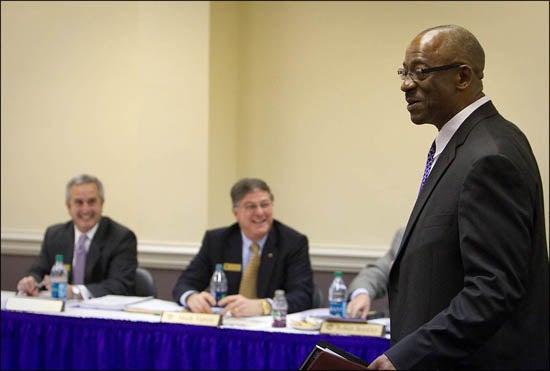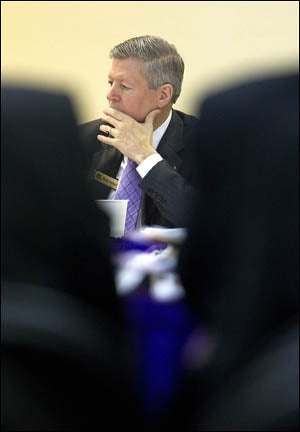FUTURE DIRECTIONS
Trustees approve master plan, consider conference affiliation

East Carolina University head football coach Ruffin McNeill speaks at the Feb. 24 meeting of the ECU Board of Trustees. (Photos by Cliff Hollis)

Chancellor Steve Ballard listens to presentations during the ECU Board of Trustees meeting.
Changes to the East Carolina University campus and its athletic conference consumed Board of Trustees members during their February meeting.
Trustees voted Feb. 24 to approve the campus master plan, which provides a framework for changes to campus during the next 15 or more years as funding allows.
Rick Niswander, vice chancellor for administration and finance, described the master plan as three years of work by many people inside and outside the university.
“This is a living document,” Niswander said while introducing representatives of the planning and architecture firm, SmithGroupJJR, who presented highlights of the master plan to the trustees Feb. 23. “It is intended to be looking 10, 15, 20 years down the road. And with the fiscal situation as it is now, we might be looking to pull that out even more.
“But none of us can know what five or 10 or 15 years from now can bring with certainty. We can provide some direction and general ideas that we need to think about as we go forward in making specific decisions,” Niswander said.
David Johnson with SmithGroupJJR described the master plan’s two primary parts: One vision for main campus and one for health sciences. The main campus plan includes downtown development and a warehouse district to the west of main campus.
A more pedestrian and bicycle friendly campus, a more unified look to the 10th Street corridor, a new performing arts center on First Street and a new alumni center downtown were all parts of the master plan highlighted for trustees.
“As we looked at campus, this edge along Fifth Street is an iconic image for the university. That’s the historic front door to the university. But what we found is that doesn’t translate to this 10th Street edge,” said Neal Kessler with the SmithGroupJJR.
“And the 10th Street edge in the future will become extremely important to the university. That’s where we’re connecting to the health sciences campus and that’s a major point where visitors first encounter the university,” Kessler said.
A new student union and parking area, a renovated Mendenhall Student Center for conferences and meetings, and a new “Academic Building A” to house business and education classes would be on that 10th Street edge, Kessler explained.
Niswander pointed out that funding for projects will be a large hurdle in the coming years.
“I think from a funding perspective that master plan gets pulled out in time. It’s directionally what we want to do, but we’re not going to be getting the money quite as fast as we want,” Niswander said after the meeting.
“In the next 10 years, there’s a reasonable chance we’re going to get money to build the biotech building, the academic building and the medical education building. And the time frame might be more. It depends on the state of the economy and some very difficult decisions that the legislature will have to make,” he said.
Moving forward, the SmithGroupJJR was selected to design a new student union building and a 500-space parking structure.
The trustees also approved the demolition and replacement plan for Belk Residence Hall, which was built in 1966. The new facility will sit at the same location and consist of two buildings housing 500 to 600 beds. In keeping with the university’s policy for all new buildings, it will have the goal to be LEED certified at completion. Ratio Architects of Raleigh were approved as the design firm.
Funding for the two new construction projects comes from student fees, Niswander said.
Changing athletic conference affiliation was another topic trustees were interested in during this month’s sessions.
Chairman Bob Lucas described the conference realignment as “a moving target. We still have an evolving process.”
Ballard attended a meeting in Dallas earlier this month when presidents and chancellors from 16 universities met to discuss future conference membership plans and agreed to work on forming a new intercollegiate athletics association.
During the Athletics and Advancement Committee meeting on Feb. 23, Chancellor Steve Ballard told the trustees, “Conferences will continue to change, evolve and move around. I don’t think we’re finished with the continuous movement of athletic conferences around the country.”
Ballard explained that television contracts “mean everything to those decisions. (The contracts) used to be one factor out of four or five,” he said. Now it’s 90 percent of the decision. “I don’t like it. I don’t think it’s value based, but it’s a given.”
The universities making up the new conference, if it is formed, would be primarily from members of Conference USA and current and future members of Mountain West.
“This merger will be the best option for East Carolina University but that could change,” Ballard said. The university presidents have 90 days to make their final decisions, he said. “Nothing will change until July 2013 so there’s time to get ready.”
Ballard told the full board that less than 2 percent of college athletes go on to play professional sports, so the guiding principle for Pirate Athletics will continue to be “the scholastic outcomes of those students.”
The trustees also voted to approve the purchase of the property at 205 E. 10th Street and 285 Easy Street, which will be used for the ECU Transit facility.
Details of the ECU master plan are available at www.ecu.edu/masterplan.
Kathryn Kennedy of ECU News Services contributed to this article.